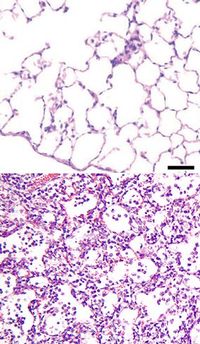M. pneumoniae is usually spread by inhalation of aerosolized particles or inhalation of the contents of the oropharnyx, of an infected individual. The contents of the oropharnyx are often ejected into the air as a result of a sneeze or cough. After inhalation of the bacterium, it travels to the respiratory epithelium found in the lungs. Another, less common path of
Normal alveoli (top) pneumonia stricken alveoli
(bottom)
 infection is through open wounds in other areas of the body. After
M. pneumoniae enters the blood stream it travels to the lungs, its
preferred habitat and multiplies.
infection is through open wounds in other areas of the body. After
M. pneumoniae enters the blood stream it travels to the lungs, its
preferred habitat and multiplies.